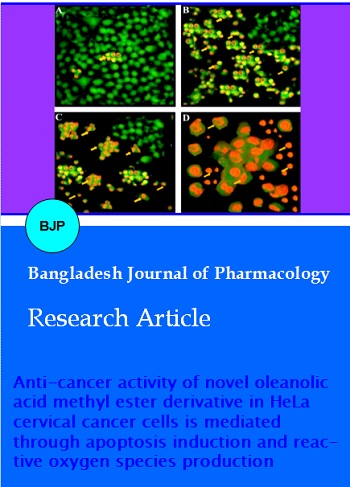Anticancer activity of novel oleanolic acid methyl ester derivative in HeLa cervical cancer cells is mediated through apoptosis induction and reactive oxygen species production
DOI:
https://doi.org/10.3329/bjp.v10i4.23709Keywords:
Anticancer, Apoptosis, HeLa cervical cancer cell, Methyl ester, Oleanolic acid, Reactive oxygen speciesAbstract
The objective of this study was to determine the anticancer and apoptotic effects of a novel oleanolic acid methyl vanillate derivative in human cervical cancer cells (HeLa). We also evaluated effect of the compound on reactive oxygen species (ROS) generation. MTT and LDH assay were used to evaluate the effect of this compound on HeLa cancer cell cytotoxicity. Confocal microscopy and flow cytometry evaluated the effect on apoptosis induction, while as ROS production was detected by using fluorescent CM-DCFH2-DA. The compound induced potent cytotoxic effects in HeLa cells in a dose-dependent as well as time-dependent manner. The compound also induced characteristic morphological changes indicative of apoptosis. The compound induced both early and late apoptosis in a concentration-dependent and time-dependent manner. The compound led to a significant and concentration dependent increase in the ROS production as the concentration of oleanolic acid methyl vanillate derivative was increased from 0 to 15, 60 and 120 ?M.
Downloads
424
286 Read
185

Published
How to Cite
Issue
Section
License
Authors who publish with this journal agree to the following terms:
- Authors retain copyright and grant the journal right of first publication with the work simultaneously licensed under a Creative Commons Attribution License that allows others to share the work with an acknowledgement of the work's authorship and initial publication in this journal.
- Authors are able to enter into separate, additional contractual arrangements for the non-exclusive distribution of the journal's published version of the work (e.g., post it to an institutional repository or publish it in a book), with an acknowledgement of its initial publication in this journal.
- Authors are permitted and encouraged to post their work online (e.g., in institutional repositories or on their website) prior to and during the submission process, as it can lead to productive exchanges, as well as earlier and greater citation of published work (See The Effect of Open Access).
